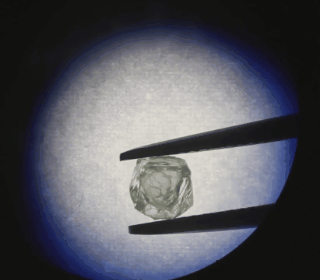Back in 2019, a diamond within a diamond was unearthed at a mine in the Sakha Republic of Siberia by the Russian mining company ALROSA. Owing to its unusual features, it was named the “Matryoshka Diamond” after Russia’s iconic stacking dolls.
Inside the lentil-sized diamond, measuring just 4.8 by 4.9 by 2.8 millimeters (0.189 by 0.193 by 0.110 inches), there is an internal cavity that contains another diamond measuring just 1.6 cubic millimeters (0.0000976 cubic inches). As you can see in the GIF below, the internal diamond is totally loose and free to rattle around the cavity inside the other diamond.
When first found, it was the only known example of a “double diamond,” but another one was later found in Australia in 2021.
“This is really a unique creation of nature, especially since nature does not like emptiness. Usually, some minerals are replaced by others without cavity formation,” Oleg Kovalchuk, deputy director for innovations at ALROSA’s Research and Development Geological Enterprise, said in a statement.

As you can see, the internal diamond is free to move around a cavity inside the other diamond. Image Credit: ALROSA
Amazed by their discovery, the mining company approached their division of Research and Development Geological Enterprise to study the diamonds using infrared spectroscopy and X-ray microtomography.
Since this had never been seen before, the researchers were not certain how the diamonds were created in such an unusual formation. Nevertheless, they put forward a few theories.
“The most interesting thing for us was to find out how the air space between the inner and outer diamonds was formed,” explained Kovalchuk. “We have two main hypotheses. According to the first version, a mantle mineral captured a diamond during its growth, and later it was dissolved in the Earth’s surface.”
“According to the second version, a layer of porous polycrystalline diamond substance was formed inside the diamond because of ultra-fast growth, and more aggressive mantle processes subsequently dissolved it. Due to the presence of the dissolved zone, one diamond began to move freely inside another on the principle of matryoshka nesting doll,” he added

An X-ray Of The Unusual Diamond. Image Credit: ALROSA
A fair number of diamonds contain other small crystals or flecks of minerals. Typically, these features are considered flaws as they render the diamond imperfect. However, according to scientific analysis by ALROSA, this internal object is actually another diamond, not an impurity.
Given their uniqueness, these features are only likely to make the diamond even more prized, although there are no details on how much the one-of-a-kind gem may be worth.
Their analysis also showed that the diamond could be over 800 million years old. That’s actually pretty young for a diamond, as most natural diamonds have ages between 1 billion and 3.5 billion years. The majority of them were forged deep in the Earth’s mantle, some 150 to 250 kilometers (93-155 miles) beneath the ground under intense heat and crushing pressure.
An original version of this article was first published in October 2019.
Source Link: This Diamond Inside Another Diamond Is A Stunning Geological Freak